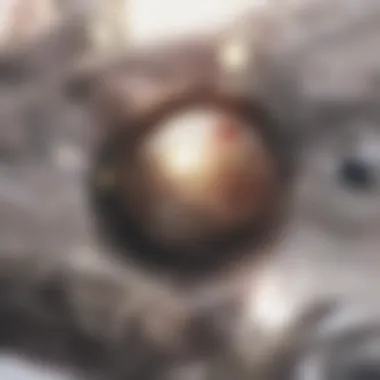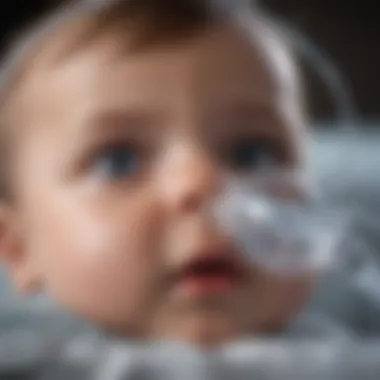Bubble CPAP Therapy in Neonates: An Overview


Intro
Bubble Continuous Positive Airway Pressure (Bubble CPAP) is gaining recognition as a vital therapeutic intervention for neonates experiencing respiratory distress. The mechanisms by which this device operates have been studied extensively, leading to improved outcomes in neonatal care. This section provides a foundational overview of the scientific rationale supporting Bubble CPAP, including its historical development and a synthesis of past research findings.
Research Background
Overview of the scientific problem addressed
Neonatal respiratory failure is a significant issue in clinical practice, particularly in preterm infants with underdeveloped lungs. These challenges may arise from conditions such as respiratory distress syndrome (RDS), which is primarily due to surfactant deficiency. Conventional ventilation methods can impose risks, including ventilator-induced lung injury. Consequently, there has been a shift toward non-invasive approaches, among which Bubble CPAP stands out for its efficacy and reduced complications.
Historical context and previous studies
The origins of CPAP date back to the late 20th century, where it was initially applied in adults for various forms of respiratory support. Its application for neonates began as studies demonstrated the feasibility and benefits of non-invasive ventilation. Research by Kinsella et al. in the early 1990s established CPAP as an effective strategy for managing neonatal respiratory distress. The introduction of the bubble CPAP system was a significant advancement, as it offered a simpler, more cost-effective, and safer means of maintaining positive airway pressure. Numerous studies have since confirmed its safety and positive impacts on outcomes for neonates, including decreased intubation rates and mortality.
Findings and Discussion
Key results of the research
Recent meta-analyses indicate that Bubble CPAP substantially lowers the risk of complications related to mechanical ventilation. For instance, one notable study revealed that infants using Bubble CPAP experienced a 40% reduction in the incidence of bronchopulmonary dysplasia. These findings underscore the potential of Bubble CPAP as a frontline strategy in neonatal care, especially considering its respiratory support capabilities without the need for invasive procedures.
Interpretation of the findings
The success of Bubble CPAP can be attributed to several key factors:
- Non-Invasiveness: Reducing the need for endotracheal intubation lowers the risk of airway trauma.
- Ease of Use: The apparatus is relatively simple to set up and requires minimal specialized training, allowing for broader application across various healthcare settings.
- Positive Outcomes: The reduction of adverse events associated with mechanical ventilation has encouraged practitioners to consider Bubble CPAP as a standard intervention in neonatology.
"Bubble CPAP has emerged not just as a therapeutic tool but as a paradigm shift in neonatal respiratory care."
As healthcare professionals seek effective management strategies, understanding the nuances and implementation of Bubble CPAP is critical. This overview emphasizes the importance of ongoing research and adaptation of practices that will better serve the needs of neonates in respiratory distress.
Prelude to Neonatal Respiratory Support
Neonatal respiratory support is an essential aspect of clinical care for newborns, particularly those who are premature or suffering from respiratory distress. Neonates, having underdeveloped lungs and respiratory systems, often face significant challenges in maintaining adequate oxygenation. This section discusses the critical nature of respiratory issues in this vulnerable population, alongside various support strategies, including the emphasis on Bubble CPAP as a primary method of intervention.
Understanding Respiratory Distress in Neonates
Respiratory distress in neonates can manifest in various forms, ranging from mild to severe. Common signs include rapid breathing, grunting, flaring of the nostrils, and cyanosis. These symptoms indicate that the infant is struggling to breathe adequately, often due to conditions such as neonatal pneumonia, surfactant deficiency, or congenital anomalies.
Understanding these underlying causes helps healthcare professionals to act swiftly and effectively. For instance, a premature newborn may experience respiratory distress syndrome due to a lack of surfactant, which is critical in reducing surface tension in the lungs. Identifying the exact cause allows for tailored interventions that can significantly improve outcomes.
Importance of Timely Intervention
Timeliness in intervention cannot be overstated when addressing neonatal respiratory distress. Delayed response can lead to serious complications, including respiratory failure or chronic lung disease. When healthcare providers recognize the signs of distress early, they can initiate appropriate support measures, such as Bubble CPAP.
Effective and prompt treatment is crucial in improving neonatal outcomes and reducing the risk of long-term health issues.
In many cases, starting support within the first hours of life can make a substantial difference. The timely application of therapies not only stabilizes the infant's condition but also minimizes potential damage to the lungs and surrounding tissues. In summary, understanding and addressing respiratory distress through immediate action is vital to the wellness of neonates.
This section establishes the framework for exploring Bubble CPAP in subsequent sections, highlighting its importance in the spectrum of neonatal respiratory support.


What is Bubble CPAP?
Understanding the concept of Bubble CPAP is crucial in neonatal care, particularly for addressing respiratory distress. This technique serves as a non-invasive method to support infants who experience difficulty in breathing. The benefits of Bubble CPAP include its relative simplicity, effectiveness, and the physiological benefits of maintaining positive airway pressure without the need for an endotracheal tube. Moreover, it is vital for healthcare professionals to grasp not just the definition, but also the fundamental working principles behind Bubble CPAP to appreciate its application fully.
Definition and Basic Concept
Bubble CPAP is fundamentally a form of Continuous Positive Airway Pressure (CPAP) therapy designed specifically for neonates. Unlike traditional CPAP systems that might utilize complex machinery, Bubble CPAP operates utilizing a very simple yet effective mechanism. It provides a continuous flow of air mixed with a certain level of oxygen through a nasal interface that sits comfortably in the infant's nostrils.
This method maintains a stable pressure in the airways, helping to keep the alveoli open during respiration. In neonates, where lung capacity and function might be underdeveloped, this continuous positive pressure can facilitate better oxygenation and ventilation, thereby reducing the work of breathing. Because it uses a simple water chamber and tubing, it allows for ease of setup and can often be readily applied in various clinical scenarios.
Mechanism of Action
The mechanism of action for Bubble CPAP is relatively straightforward but involves several important physiological principles. The therapy works by generating bubbles in water, which create a consistent pressure as the air flows through the water. This flow of air generates a slight resistance, effectively creating a pressure within the infant's lungs during both inhalation and exhalation.
This pressure helps to:
- Maintain Alveolar Recruitment: By preventing alveolar collapse, it increases surface area for gas exchange.
- Reduce Work of Breathing: By providing a supportive pressure, infants can breathe more easily, minimizing respiratory fatigue.
- Enhance Oxygenation: Increased intrathoracic pressure can improve oxygen uptake and carbon dioxide clearance.
Healthcare professionals must monitor the setup closely, as both the pressure levels and the oxygen concentration must be adjusted to meet the specific needs of the individual neonate. A well-implemented Bubble CPAP can lead to significant improvements in the overall respiratory status, enhancing the neonate's capacity to thrive.
Important: Effective use of Bubble CPAP requires an understanding of proper settings and clinical indications to achieve the maximum benefit with minimal risk of complications.
Indications for Bubble CPAP in Neonates
Bubble CPAP occupies a crucial role in the management of respiratory distress in neonates. Understanding the indications for its use is essential for practitioners in neonatal care, as timely intervention can significantly improve patient outcomes. The primary aim of Bubble CPAP is to maintain a consistent airway pressure that facilitates adequate oxygenation and ventilation. This method is not just a treatment but a lifeline for many infants with respiratory challenges.
Common Conditions Requiring CPAP
Several clinical conditions warrant the application of Bubble CPAP. These include:
- Respiratory Distress Syndrome (RDS): This condition, often seen in premature infants, is characterized by insufficient surfactant production, leading to atelectasis and impaired gas exchange. Bubble CPAP can help to stabilize the alveoli and promote better lung function.
- Transient Tachypnea of the Newborn (TTN): This self-limiting condition is common in neonates, particularly those delivered via Cesarean section. Bubble CPAP assists in reducing respiratory effort by providing extra support, thereby speeding up recovery.
- Pneumonia: Neonatal pneumonia can complicate respiratory function. Here, the application of continuous positive airway pressure can prevent the collapse of alveoli, thus improving ventilation.
- Meconium Aspiration Syndrome: In this condition, neonates inhale meconium while in the womb, which can obstruct the airways. Bubble CPAP can assist in clearing the airways and improve oxygenation.
The effectiveness of Bubble CPAP in these conditions has made it an essential tool in neonatal intensive care units (NICUs).
Clinical Guidelines for Use
The application of Bubble CPAP must follow clinical guidelines to ensure optimal outcomes. Practitioners should consider the following points:
- Patient Selection: Not every neonate with respiratory distress will benefit from CPAP. It is critical to assess the underlying cause and the overall clinical picture.
- Initial Settings: The initial pressure settings should be based on the infant's weight and clinical condition. Typically, starting pressures range from 4 to 6 cm O but need careful adjustment based on the infant's responses.
- Monitoring: Continuous monitoring of vital signs and oxygen saturation is necessary. This allows for timely modifications to therapy as needed.
- Duration of Therapy: The length of treatment with Bubble CPAP varies, and it should be reassessed regularly to determine if it remains appropriate as the infant's condition evolves.
Clinical Application of Bubble CPAP
The clinical application of Bubble CPAP is vital in the context of neonatal care. This method provides a simple yet effective respiratory support for infants who experience breathing difficulties. The implementation of this therapy helps maintain adequate oxygenation and ventilation in neonates, often in circumstances where traditional methods may not be feasible. Bubble CPAP is particularly suitable in neonatal intensive care units (NICUs), where timely and effective intervention is crucial for patient outcomes.
Setting Up Bubble CPAP
Setting up Bubble CPAP requires attention to detail and an understanding of the specific needs of neonates. The device typically consists of a flow generator, a water chamber, and nasal prongs. Each component serves a distinct purpose in delivering positive pressure to the infant's airways.
- Preparation: Ensure the equipment is sterile and functional. Check for leaks in the circuit as this could compromise effectiveness.
- Water Level: Fill the water chamber to the recommended level. The water acts as a medium for creating bubbles, which generate pressure when air passes through.
- Positioning the Infant: Position the neonate to allow for optimal airflow. The head should be in a neutral position to maximize ease of breathing.
- Attaching Nasal Prongs: Choose appropriately sized nasal prongs and secure them gently in the infant's nostrils. Tightness or discomfort can lead to compliance issues.
- Monitor Initial Settings: Adjust the flow rates according to protocols and start therapy after confirming correct setup.
Monitoring During Therapy


Continuous monitoring during Bubble CPAP therapy is essential for the safety and well-being of the neonate. Clinicians should focus on several key indicators to ensure that the therapy is effective and to identify any potential issues early on.
- Vital Signs: Regularly assess heart rate, respiratory rate, and oxygen saturation levels. Any deviations from normal ranges can indicate distress.
- Work of Breathing: Monitor the neonate for signs of increased work of breathing. This might include retractions, nasal flaring, or grunting.
- Fluid Balance: Keep track of fluid intake, as excessive fluid can lead to respiratory complications.
- Skin Integrity: Inspect the areas around the nasal prongs for pressure sores or irritation. This is vital to prevent complications associated with prolonged use.
Monitoring is not just a clinical duty; it is a lifeline that connects medical staff with optimal patient outcomes.
Bubble CPAP offers a non-invasive approach to respiratory support, making it an advantage in managing neonatal health. Understanding the setup process and maintaining vigilant monitoring are critical steps in employing this therapy effectively.
Comparison with Other CPAP Methods
In the field of neonatal respiratory support, Comparison with Other CPAP Methods is a significant topic due to its implications for treatment efficacy and patient outcomes. Bubble CPAP, while innovative, stands amid various existing continuous positive airway pressure therapies. Understanding the differences between these methods can help clinicians determine the best approach tailored to each neonate's specific needs.
Traditional CPAP vs. Bubble CPAP
Traditional CPAP systems typically involve a mechanical ventilator that delivers a set pressure to maintain airway patency. This method offers precise control over the delivered pressure but often relies on complex machinery, which can be bulky and challenging to maneuver in tight neonatal units.
Bubble CPAP, on the other hand, uses a simpler design. It delivers continuous positive airway pressure through a water interface that generates bubbles as gas flows through it. This mechanism is beneficial because it helps to reduce the risk of barotrauma, a common concern in traditional CPAP usage. It also allows for ease of use and flexibility in diverse clinical settings.
The advantages of Bubble CPAP become clearer when considering specific patient factors. Traditional methods may necessitate invasive modes, which might not be suitable for all neonates, particularly those with less severe distress. Bubble CPAP provides a less invasive alternative that can be easily adjusted, offering a more gradual approach to treatment.
Advantages of Bubble CPAP
The shift towards Bubble CPAP in neonatal care comes with various advantages:
- Simplicity and Ease of Use: The design is less complex compared to mechanical CPAP systems, reducing the learning curve for healthcare staff.
- Comfort for the Neonate: The gentler pressure profile produced by bubbles often results in improved comfort for infants, decreasing the chance of stress during treatment.
- Lower Incidence of Complications: As mentioned, the non-invasive nature of Bubble CPAP can lead to a reduced risk of complications typically associated with traditional therapies, such as ventilator-induced lung injury.
- Flexibility in Application: Bubble CPAP can be deployed effectively in both high-resource and low-resource settings, making it versatile in various healthcare environments.
"Emerging evidence supports the notion that non-invasive techniques like Bubble CPAP can yield successful outcomes while promoting a more stable lung environment for the neonate."
By analyzing the differences between Bubble CPAP and traditional methods, clinicians can make informed decisions about which therapy is most appropriate for their patients. Ongoing research will likely refine these comparisons further, providing additional clarity on the optimal use of respiratory support techniques in neonates.
Efficacy and Outcomes of Bubble CPAP
In the realm of neonatal respiratory care, assessing the efficacy and outcomes of Bubble CPAP is essential, as it directly correlates with improvements in survival rates and overall health of neonates experiencing respiratory distress. As healthcare providers strive for optimal performance in therapeutic interventions, understanding how Bubble CPAP functions in real-world clinical settings becomes critical for informed decision-making.
Review of Clinical Studies
Numerous clinical studies have been conducted to evaluate the effectiveness of Bubble CPAP. One comprehensive review highlights that Bubble CPAP significantly reduced the need for mechanical ventilation in neonates with respiratory distress syndrome. In particular, studies focusing on preterm infants demonstrated a marked decrease in associated morbidities such as bronchopulmonary dysplasia and prolonged hospitalization.
The Journal of Pediatrics reported a series of trials where Bubble CPAP was implemented in Neonatal Intensive Care Units (NICUs). The findings consistently indicated that neonates receiving Bubble CPAP showed improvements in oxygenation levels and respiratory rates compared to those on other forms of respiratory support. Moreover, a meta-analysis underscored the reduction in treatment failures with Bubble CPAP, emphasizing its role as a first-line therapy for mild to moderate respiratory distress.
"The integration of Bubble CPAP in clinical practice has reshaped the approach to neonatal respiratory support, enabling better outcomes and fewer complications."
Key Performance Indicators
Evaluating the performance of Bubble CPAP requires specific metrics and indicators. Among the critical performance indicators, the following stand out:
- Reduction in Intubation Rates: A key benchmark for success is the reduction in the number of patients requiring endotracheal intubation. Studies show that with effective use of Bubble CPAP, rates drop significantly.
- Oxygenation Improvement: Monitoring changes in oxygen saturation levels (SpO2) is essential. A consistent improvement indicates effective ventilation and gas exchange.
- Duration of Therapy: The length of time a neonate remains on CPAP is another vital indicator. Shorter durations typically reflect better outcomes and reduced risk of complications.
- Length of NICU Stay: By tracking how long infants spend in the NICU after Bubble CPAP initiation, healthcare professionals can determine efficiency and overall effectiveness.
These indicators not only provide measurable outcomes but also lend insight into the comparative advantage of Bubble CPAP relative to other respiratory support systems.
Potential Risks and Complications


In the context of neonatal respiratory support, understanding the potential risks and complications associated with bubble CPAP is of paramount importance. While bubble CPAP is generally considered a safe and effective method for managing respiratory distress in neonates, it is not without its challenges. Awareness of these risks allows healthcare professionals to make informed decisions and implement measures to minimize complications.
Common Complications
Neonates receiving bubble CPAP therapy may encounter several complications that can affect their clinical outcomes. Some of the most common complications include:
- Air Leak: This occurs when air escapes from the system, which can lead to inadequate pressure delivery. An air leak may compromise the effectiveness of oxygenation and ventilation.
- Barotrauma: This is a condition caused by excessive pressure in the lungs. Over-distention can cause lung injury, leading to pneumothorax.
- Skin Irritation: The interface used to connect the bubble CPAP device to the neonate can create pressure points on the skin, leading to irritation or sores.
- Infection Risk: As with any respiratory intervention, there is a potential risk of introducing pathogens into the airways, which can result in respiratory infections.
- Apnea: Some neonates may experience episodes of apnea, where breathing temporarily stops. This can occur due to various reasons, including underlying conditions and the stress of therapy.
Regular monitoring is crucial to identify and address these complications promptly.
Preventative Measures
To mitigate the risks associated with bubble CPAP, implementing preventative measures is essential. Healthcare practitioners should consider the following strategies:
- Proper Equipment Setup: Ensuring all equipment is set up correctly can help minimize the risk of air leaks and other complications. Check all connections and seals before initiating therapy.
- Skin Care Protocols: Implementing preventive skin care measures can reduce the incidence of skin irritation. Regularly assess the skin for pressure points and use appropriate dressings as needed.
- Training and Education: Healthcare teams should receive ongoing training to stay updated on best practices for bubble CPAP use. Well-trained staff can recognize complications earlier and act accordingly.
- Regular Monitoring: Continuous monitoring of the neonate's clinical status allows for early identification of any issues. It is important to have protocols in place for frequent assessment of respiratory status and vital signs.
- Adjustment of Therapy: Physicians should be prepared to adjust bubble CPAP settings based on the neonate’s condition and response to therapy. This includes fine-tuning pressure levels and weaning strategies where necessary.
Future Directions in Research
Research in Bubble CPAP therapy for neonates is vital to improve outcomes in neonatal respiratory care. As more healthcare professionals recognize the importance of effective respiratory support, the push for innovation becomes paramount. Future research directions can provide valuable insights into device design, technique optimization, and application for varying types of neonatal respiratory distress.
Emerging Technologies in CPAP
Emerging technologies hold the potential to revolutionize Bubble CPAP applications. One avenue under investigation includes the integration of smart technology. Devices that can autonomously adjust pressure levels based on real-time feedback could enhance therapeutic effectiveness. These systems may incorporate sensors that monitor the neonate's breathing patterns, ensuring that CPAP is delivered at the most beneficial rates.
In addition, the development of more compact and portable Bubble CPAP devices may facilitate their use in varied settings. These innovations can expand accessibility to rural or resource-limited areas, ensuring more neonates receive essential respiratory support.
Moreover, advances in materials and designs could reduce the overall weight of equipment, making transportation easier within healthcare facilities.
Opportunities for Clinical Trials
Clinical trials focusing on Bubble CPAP can pave the way for furthering knowledge and efficacy in treatment protocols. One significant opportunity lies in conducting randomized controlled trials comparing Bubble CPAP with other CPAP methods. Such research can help identify the specific patient populations that benefit the most from Bubble CPAP, thus guiding clinical practice.
Additionally, trials that explore long-term outcomes from Bubble CPAP treatment may provide insights into its effectiveness over an extended period, informing healthcare protocols. For example, the monitoring of development and health outcomes in babies treated with Bubble CPAP versus alternatives can yield critical data.
Furthermore, research examining the cost-effectiveness of Bubble CPAP compared to other neonatal care options will inform resource allocation decisions in hospitals. This can ultimately influence the health policies related to neonatal care.
"Research is pivotal for advancing medical practices, allowing us to adapt to future challenges and improve patient outcomes."
As we explore these innovative technologies and clinical trial opportunities, it will be essential to maintain a balanced focus on safety and efficacy. This will ensure that any advancements in Bubble CPAP therapy not only enhance care but also prioritize the well-being of neonates.
Ending
The conclusion synthesizes the crucial information discussed throughout the article about bubble CPAP therapy for neonates. This summary emphasizes key insights, the relevance of findings, and the broader implications in neonatal care. Recognizing the importance of implementing effective respiratory support can significantly impact a newborn's health. As outlined, bubble CPAP serves as a vital intervention that enhances oxygenation and reduces the work of breathing for infants experiencing respiratory distress.
Summarizing Key Takeaways
- Mechanism and Functionality: Bubble CPAP operates by delivering continuous positive airway pressure, utilizing a simple yet effective design that aids in expanding the lungs of infants.
- Efficacy: Clinical evidence indicates that bubble CPAP can lead to improved oxygenation and decreases the need for more invasive interventions.
- Applications: This method is especially beneficial for conditions like apnea of prematurity, respiratory distress syndrome, and other neonatal challenges requiring respiratory support.
- Safety: Unlike traditional CPAP, bubble CPAP minimizes the risk of trauma to the airway while providing necessary support, making it preferable in many clinical situations.
Overall, the effectiveness and safety profile of bubble CPAP, coupled with its simplicity, make it an essential tool in neonatal respiratory care.
Implications for Practice
Healthcare professionals must remain vigilant in recognizing neonatal respiratory distress and implementing timely interventions. The use of bubble CPAP highlights the importance of individualized patient care in neonatology. Key considerations for practice include:
- Training and Competency: Staff should be trained on proper setup and monitoring of bubble CPAP equipment to ensure the effectiveness of therapy.
- Regular Assessment: Ongoing patient assessments are necessary to adjust treatments as the neonate’s condition changes.
- Collaboration: Interdisciplinary teamwork is vital to optimize outcomes; this includes close collaboration among neonatologists, nurses, respiratory therapists, and parents.
Furthermore, healthcare institutions should prioritize research and development in this field. Investing in future studies will continue to advance understanding and enhance practices surrounding bubble CPAP usage in neonates. As the clinical landscape evolves, it is crucial to remain informed of emerging technologies and innovative approaches that could benefit neonatal care.







